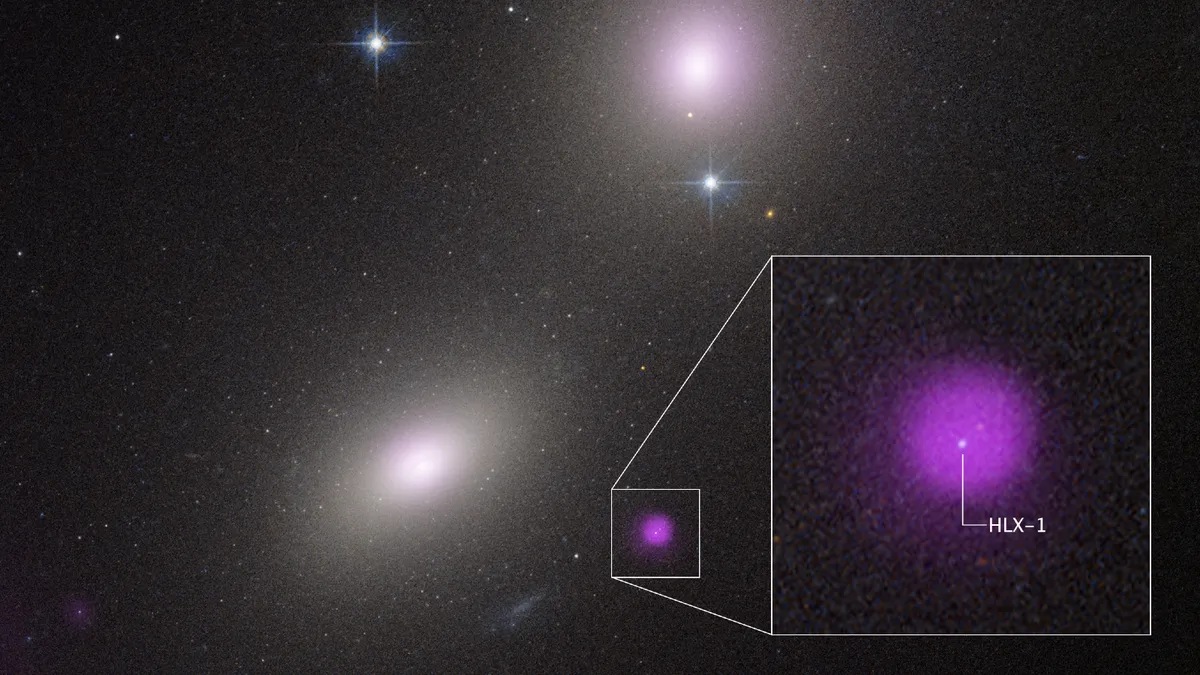
A rogue, middle-mass black hole has been identified disrupting an orbiting star within the halo of a distant galaxy, thanks to the advanced capabilities of the Hubble Space Telescope and the Chandra X-ray Observatory. This groundbreaking discovery raises intriguing questions about the nature of the black hole's interaction with the star, as there appear to be conflicting X-ray measurements that complicate our understanding.
Black holes are categorized into various size classes. At the lower end of the spectrum, we find stellar-mass black holes, which are formed from the remnants of supernova explosions. At the opposite extreme, supermassive black holes can possess masses ranging from millions to billions of times that of our sun, typically residing in the centers of galaxies. In between these two categories lies the intermediate-mass black hole (IMBH), which can weigh anywhere from hundreds to about 100,000 solar masses. According to Yi-Chi Chang from the National Tsing Hua University in Hsinchu, Taiwan, IMBHs represent a crucial missing link in our understanding of black hole evolution between stellar and supermassive black holes.
Finding intermediate-mass black holes poses significant challenges for astronomers. These black holes are often less active than their supermassive counterparts and do not exhibit the same visibility as stellar-mass black holes during supernova events. However, IMBHs can become more detectable when they trigger a tidal disruption event. This phenomenon occurs when a star or gas cloud ventures too close to the black hole, leading to gravitational tidal forces that tear the star or gas apart, resulting in bursts of X-ray emissions. Chang emphasizes that such extreme X-ray sources are rare outside of galaxy nuclei, making them vital for identifying elusive IMBHs.
In 2009, the Chandra Observatory detected unusual X-ray emissions from a region approximately 40,000 light-years from the center of a giant elliptical galaxy known as NGC 6099, which is located 453 million light-years away from Earth. This bright X-ray source was designated as HLX-1, and its X-ray spectrum suggested temperatures reaching 5.4 million degrees Fahrenheit (or 3 million degrees Celsius), indicative of a violent tidal disruption event.
However, follow-up observations revealed unexpected results. The X-ray emissions peaked in brightness in 2012 when observed by the European Space Agency's XMM-Newton X-ray space telescope, but subsequent measurements in 2023 showed a significant decline in luminosity. Meanwhile, the Canada–France Hawaii Telescope identified an optical counterpart for the X-ray emissions, which was later confirmed by Hubble.
Two primary hypotheses arise regarding the observed phenomena. The first suggests that Hubble's spectrum indicates a tight cluster of stars orbiting the black hole. This black hole may have once been at the core of a dwarf galaxy that was stripped away by the gravitational forces of NGC 6099, leaving behind a solitary black hole accompanied by a small cluster of stars. This scenario implies that the black hole has a "stellar pantry" from which it occasionally feasts.
The second hypothesis posits that the star was gradually torn apart, forming a stream of material around the black hole. Initially, when Chandra detected the X-ray emissions, this stream was just beginning to coalesce, creating shock-heating that produced X-rays. By 2012, the star would have been completely ripped apart, forming a hot accretion disk of gas, which has since spiraled into the black hole, resulting in the decreased luminosity observed in 2023.
Distinguishing between these scenarios will require further observations. The rate at which the IMBH consumes the star's gas remains uncertain. HLX-1 was relatively bright in 2009, peaked in brightness in 2012, and has since shown a decline in luminosity. Roberto Soria from the Italian National Institute for Astrophysics (INAF) notes that it is crucial to monitor whether the black hole will exhibit multiple flares or if the brightness cycle will eventually fade completely.
Understanding the dynamics of IMBHs like HLX-1 is essential for grasping their role within the black hole ecosystem. One prevailing model suggests that supermassive black holes may form and grow through the merger of multiple IMBHs. However, the prevalence of intermediate-mass black holes in the universe remains unclear. Soria expresses optimism that with luck, astronomers will discover more free-floating black holes becoming X-ray bright due to tidal disruption events.
Currently, the limitations of Chandra, XMM-Newton, and Hubble, which each have small fields of view, hinder astronomers from pinpointing the location of future tidal disruption events. The chances of these telescopes observing such events at the right time are minimal. Fortunately, the upcoming launch of the Vera C. Rubin Observatory will significantly enhance observational capabilities. This observatory will conduct a comprehensive 10-year all-sky survey, making it easier to detect flares from tidal disruption events. Once identified, Hubble and Chandra can follow up with targeted observations.
In conclusion, while intermediate-mass black holes have remained largely hidden within the cosmos, advancements in observational technology and ongoing studies promise to shed light on these elusive entities and their significant role in the universe's evolution.